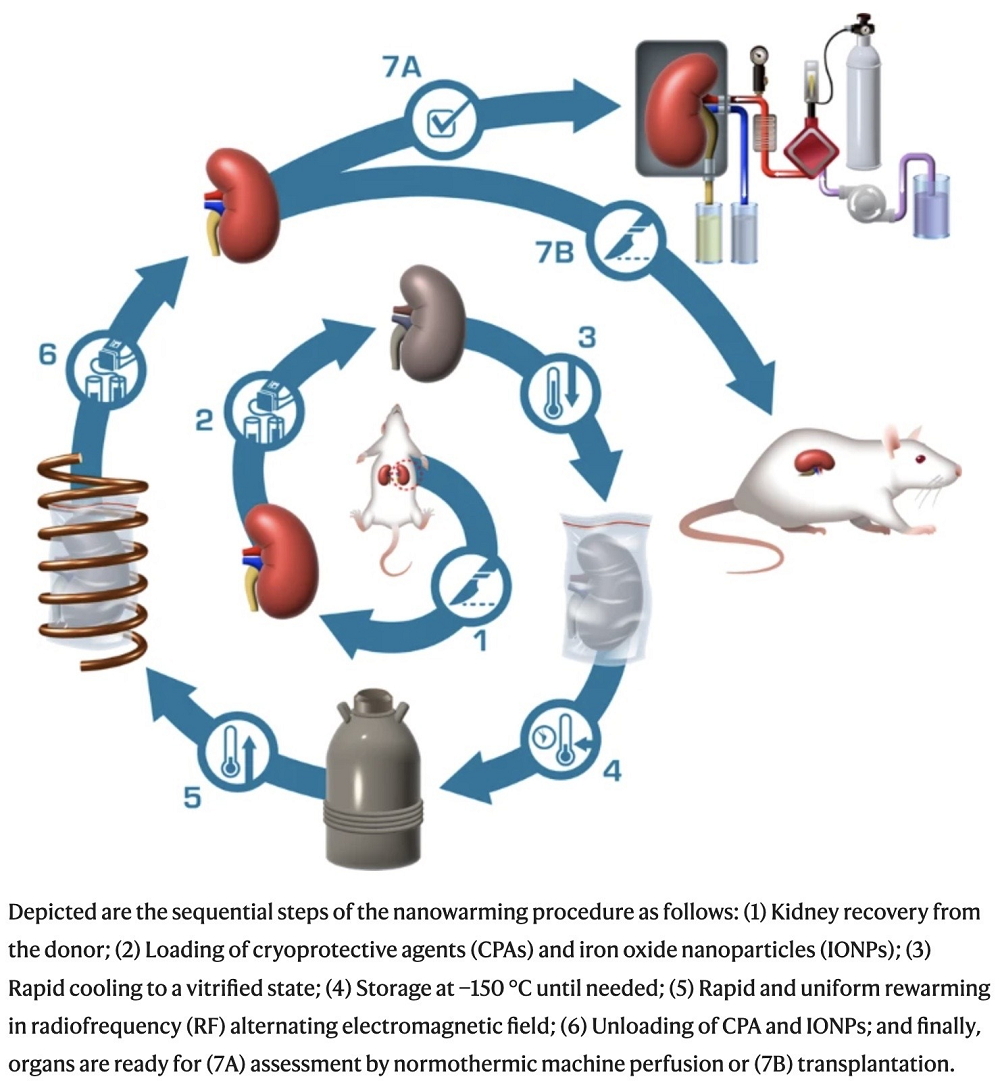For the first time in history, scientists have been able to freeze, preserve, rewarm, and transplant rat kidneys with a new method of organ cryopreservation [1].
The rewarming problem
Today, organ transplantation is severely limited by the fact that organs can only be preserved for a short time in near-freezing temperatures. Long-term cryopreservation of organs could save countless lives, but it has eluded scientists for decades, even though we can freeze and unfreeze blood, sperm, and embryos.
Many hurdles must be overcome on the way to successful organ cryopreservation. First, the organ must be frozen in a way that avoids the formation of tissue-destroying ice crystals. This demands quick freezing and the use of cryoprotective agents (CPAs), which can themselves be toxic. The second major problem is achieving quick and uniform rewarming. While the former has been mostly solved by a freezing technology called vitrification [2], the latter remains.
Central heating for a kidney
In this new paper published in Nature Communications, a group of researchers from the University of Minnesota reports using a groundbreaking rewarming technique to successfully transplant vitrified and rewarmed kidneys into rats.
The researchers call their technique “nanowarming” because it involves adding iron oxide nanoparticles to the CPA solution that the kidney is flooded with prior to vitrification. When it’s time to rewarm the kidney, a radiofrequency coil induces alternating magnetic fields that heat the nanoparticles uniformly, regardless of how deep in the organ tissue they reside. Essentially, the organ is heated from the inside instead of outside. After the kidney is rewarmed, the CPAs, along with the nanoparticles, are flushed out of it, and the organ is ready for transplantation.
Success in vitro and in vivo
First, the researchers vitrified several rat kidneys, which involved quickly cooling the organs to below the vitrification temperature of -128?°C. The kidneys were then stored at the same temperature for up to 100 days.
The researchers then tested the function of several rewarmed kidneys ex vivo by connecting the organs to machines instead of transplanting them into actual animals. As controls, they used kidneys that had been cold-stored at 4?°C for 24 hours and kidneys that were flushed with the CPA solution without the iron oxide nanoparticles, and neither of these vitrified nor rewarmed.

In creatinine clearance, a major marker of kidney function, the rewarmed kidneys performed worse than the fresh ones but on par with CPA-flushed kidneys, which suggests that this non-critical loss of function was due to CPA toxicity rather than to the vitrification/rewarming process. Both rewarmed and CPA-flushed kidneys also did mostly as well as the cold-stored ones. Urine production was close to normal in all the groups.
In vivo experiments showed that, after an initial period of adjustment, nanowarmed kidneys performed in live rats just as well as fresh transplants. All major markers of kidney function became normalized one to two weeks after the transplantation.
Among the study’s limitations are the small sample size (4 to 8 rats per group) and a rather short follow-up period. After 30 days, the rats were sacrificed for histological analysis, which showed that the kidneys were in good shape. Serum and urine analyses also returned normal results. Extrapolating using data from human transplantations, the researchers predict good long-term outcomes.
Clearing out junk is not the only kidney function. Kidneys also make erythropoietin, a hormone that stimulates red blood cell production, and convert vitamin D to its active form. Both of those functions also appeared normal at the end of the follow-up period.
Successful cryobanking of human organs prior to transplant would revolutionize how organs are recovered, allocated, and ultimately used to cure end-stage organ disease. Organ banking would improve donor/recipient matching, allow for better patient preparation and scheduled procedures, facilitate tolerance induction protocols in recipients, and increase organ utilization—all while supporting graft and patient survival. Here we show the first repeatable approach for successful cryopreservation of intact organs (rat kidneys) for up to 100 days prior to transplantation. Nanowarmed organs restored renal function and solely sustained the lives of nephrectomized transplant recipients for 30 days post transplant. These results show that prolonged organ banking for transplantation may finally be possible.
The dawn of a new era?
To put this achievement into perspective, the last time that a mammalian organ was reported to be successfully vitrified, rewarmed, and transplanted was by Greg Fahy et al. back in 2009 [3]. That single successful transplantation of a rewarmed rabbit kidney has never been reproduced.
Most importantly, nanowarming is size-independent. Since radio waves penetrate any amount of tissue, the rewarming should be just as smooth and uniform even in large human organs. However, this will have to be tested in future experiments. In case of success, this new technology has the potential not only to upend the current transplantation paradigm but to open new possibilities for whole-body cryopreservation.









































